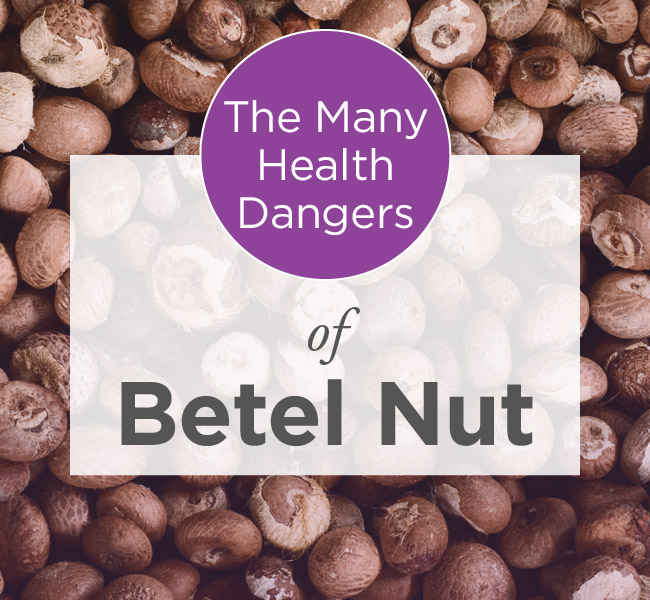Betel quid chewing & cancer
November 30th, 2017“…..People start to enjoy the betel quid chewing starting in the
adolescence, and is associated with alcohol drinking and smoking. The
practice can lead to oral cancer.
In 2017, 67 (22 percent) out of 307 cancer patients in Taungoo public
hospital were suffering from head and neck cancer. Among them, 41 were
males and 26 were females. Males were aged in average 59.2 years
(range 36-81 years) and females were about 58.7 years old (range 19-86
years). Most of the cancers were in the oral cavity (34.3 percent),
followed by larynx (25.4 percent), oropharynx (11.9 percent),
nasopharynx (11.9 percent), hypopharynx (10.4 percent), lips (4.5
percent), and nose (1.5 percent).
As for social factors, about 20 patients (30 percent) had the habit of
betel quid chewing, 19 patients (28 percent) chewed betel quid and
smoked, and 19 patients (28 percent) chewed betel quid, smoked, and
drank alcohol…..”
Betel Quid with Tobacco (Gutka)
Betel quid is a combination of betel leaf, areca nut, and slaked lime.
In many countries, tobacco is also added, and the product is known as gutka, ghutka, or gutkha.
Other ingredients and flavorants are also added according to local preferences and customs (e.g., sweeteners, catechu, or spices such as cardamom, saffron, cloves, anise seeds, turmeric, and mustard).
Gutka is commercially available in foil packets and tins and is consumed by placing a pinch of the mixture in the mouth between the gum and cheek and gently sucking and chewing. The excess saliva produced by chewing may be swallowed or spit out.2
Use
- Betel quid and gutka use is reported to have stimulant and relaxation effects.2
- Global estimates report that up to 600 million men and women use some variety of betel quid.2
- Betel quid with or without tobacco is widely used in the Indian subcontinent (i.e., Bangladesh, India, Pakistan) as well as throughout Asia and the Pacific region (e.g., Cambodia, China, Indonesia, Malaysia, Philippines, Taiwan, Thailand).1,2,3,5
Health Effects
The following conditions have been associated with betel quid/gutka use:
Precancerous conditions
- Oral precancerous lesions, including erythroplakia (a reddened patch in the mouth) and leukoplakia (a white patch on the mucous membranes in the mouth that cannot be wiped off).2,6
- Oral submucous fibrosis (OSF), a precancerous lesion that stiffens the soft pink tissue that lines the inside of the mouth (i.e., oral mucosa).
Cancer
- Oral cancers—predominantly carcinomas of the lip, mouth, tongue, and pharynx2,6,8
- Cancer of the esophagus2
Other health effects
- Reproductive health outcomes such as increased risk of having a low birth-weight infant7
- Nicotine addiction4
References
- National Cancer Institute, Centers for Disease Control and Prevention, Stockholm Centre of Public Health. Smokeless Tobacco Fact Sheets. Third International Conference on Smokeless Tobacco; Stockholm. September 22–25, 2002 [cited 2015 Nov 27].
- World Health Organization. Betel-Quid and Areca-Nut Chewing and Some Areca-Nut-Derived Nitrosamines; Volume 85 [PDF–7.44 MB]. Lyon (France): World Health Organization, International Agency for Research on Cancer, 2004 [accessed 2015 Nov 27].
- Global Surveillance of Oral Tobacco Products: Total Nicotine, Unionised Nicotine and Tobacco-Specific N-nitrosamines. Tobacco Control 2011;20:e2, May 1, 2011 (10.1136/tc.2010.037465) [cited 2015 Nov 27].
- World Health Organization. Tobacco: Deadly in Any Form or Disguise
[PDF–2.58 MB]. Geneva: World Health Organization, 2006 [accessed 2015 Nov 27]. - Centers for Disease Control and Prevention. Use of Cigarettes and Other Tobacco Products Among Students Aged 13–15 Years—Worldwide, 1999–2005. Morbidity and Mortality Weekly Report 2006;55(20):553–6 [accessed 2015 Nov 27].
- Alert for an Epidemic of Oral Cancer Due to Use of the Betel Quid Substitutes Gutkha and Pan Masala: A Review of Agents and Causative Mechanisms. Mutagenesi 2004;19(9):251–62 [accessed 2015 Nov 27].
- Smokeless Tobacco and Health in India and South Asia. Respirology 2003;8(4):419–31 [cited 2015 Nov 27].
- Epidemiology of Betel Quid Usage [PDF–43.77 KB]. Annals Academy of Medicine Singapore 2004;33(Suppl):31S–36S [accessed 2015 Nov 27].
For Further Information
Centers for Disease Control and Prevention
National Center for Chronic Disease Prevention and Health Promotion
Office on Smoking and Health
E-mail: tobaccoinfo@cdc.gov
Phone: 1-800-CDC-INFO
Media Inquiries: Contact CDC’s Office on Smoking and Health press line at 770-488-5493.


